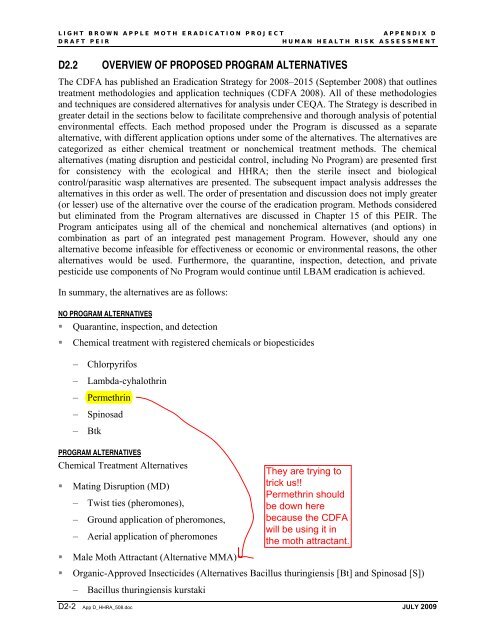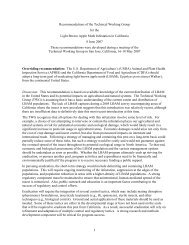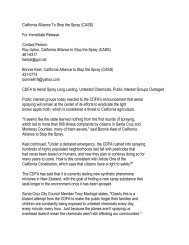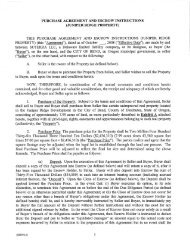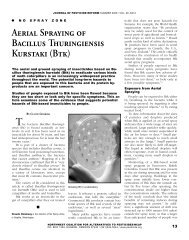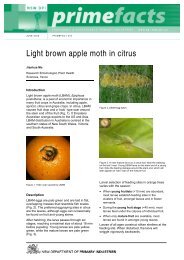Debunking Human Health Risk, APPENDIX D - LBAMspray.com
Debunking Human Health Risk, APPENDIX D - LBAMspray.com
Debunking Human Health Risk, APPENDIX D - LBAMspray.com
Create successful ePaper yourself
Turn your PDF publications into a flip-book with our unique Google optimized e-Paper software.
LIGHT BROWN APPLE MOTH ERADICATION PROJECT<br />
<strong>APPENDIX</strong> D<br />
DRAFT PEIR<br />
HUMAN HEALTH RISK ASSESSMENT<br />
D2.2 OVERVIEW OF PROPOSED PROGRAM ALTERNATIVES<br />
The CDFA has published an Eradication Strategy for 2008–2015 (September 2008) that outlines<br />
treatment methodologies and application techniques (CDFA 2008). All of these methodologies<br />
and techniques are considered alternatives for analysis under CEQA. The Strategy is described in<br />
greater detail in the sections below to facilitate <strong>com</strong>prehensive and thorough analysis of potential<br />
environmental effects. Each method proposed under the Program is discussed as a separate<br />
alternative, with different application options under some of the alternatives. The alternatives are<br />
categorized as either chemical treatment or nonchemical treatment methods. The chemical<br />
alternatives (mating disruption and pesticidal control, including No Program) are presented first<br />
for consistency with the ecological and HHRA; then the sterile insect and biological<br />
control/parasitic wasp alternatives are presented. The subsequent impact analysis addresses the<br />
alternatives in this order as well. The order of presentation and discussion does not imply greater<br />
(or lesser) use of the alternative over the course of the eradication program. Methods considered<br />
but eliminated from the Program alternatives are discussed in Chapter 15 of this PEIR. The<br />
Program anticipates using all of the chemical and nonchemical alternatives (and options) in<br />
<strong>com</strong>bination as part of an integrated pest management Program. However, should any one<br />
alternative be<strong>com</strong>e infeasible for effectiveness or economic or environmental reasons, the other<br />
alternatives would be used. Furthermore, the quarantine, inspection, detection, and private<br />
pesticide use <strong>com</strong>ponents of No Program would continue until LBAM eradication is achieved.<br />
In summary, the alternatives are as follows:<br />
NO PROGRAM ALTERNATIVES<br />
• Quarantine, inspection, and detection<br />
• Chemical treatment with registered chemicals or biopesticides<br />
Chlorpyrifos<br />
Lambda-cyhalothrin<br />
Permethrin<br />
Spinosad<br />
Btk<br />
PROGRAM ALTERNATIVES<br />
Chemical Treatment Alternatives<br />
• Mating Disruption (MD)<br />
Twist ties (pheromones),<br />
Ground application of pheromones,<br />
Aerial application of pheromones<br />
• Male Moth Attractant (Alternative MMA)<br />
• Organic-Approved Insecticides (Alternatives Bacillus thuringiensis [Bt] and Spinosad [S])<br />
Bacillus thuringiensis kurstaki<br />
D2-2 App D_HHRA_508.doc JULY 2009


